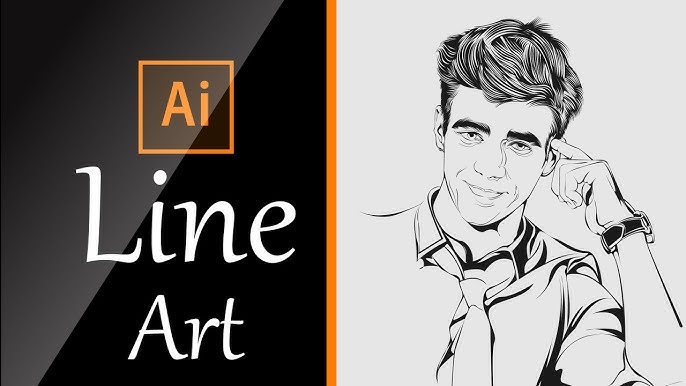Mastering Vector Line Drawings: A Comprehensive Guide to Creating Striking Artwork in Adobe Illustrator

Introduction: Vector line drawings are powerful artistic expressions that rely on simple lines and shapes to convey complex subjects and emotions. Adobe Illustrator, with its robust vector-based tools and extensive features, provides artists with a versatile platform to create stunning line drawings with precision and flexibility. In this comprehensive guide, we’ll explore the step-by-step process of creating vector line drawings in Adobe Illustrator, covering everything from sketching to final refinement.
Section 1: Understanding Vector Line Drawings 1.1 What are Vector Line Drawings?: Explore the concept of vector line drawings and their significance as minimalist yet expressive art forms that capture the essence of subjects with precision. 1.2 Advantages of Vector Line Drawings: Examine the advantages of creating line drawings in vector format, including scalability, editability, and the ability to maintain crispness and clarity at any size. 1.3 Types of Vector Line Drawings: Discover different styles and techniques of vector line drawings, from simple sketches to intricate illustrations, and their respective applications and aesthetic qualities.
Section 2: Getting Started with Adobe Illustrator 2.1 Overview of Adobe Illustrator: Familiarize yourself with the Illustrator workspace, tools, and essential features for creating vector line drawings. 2.2 Setting Up Your Document: Create a new document in Illustrator, specifying the dimensions, resolution, and color mode suitable for your line drawing project. 2.3 Customizing Preferences: Adjust Illustrator preferences and settings to optimize your workflow for creating vector line drawings, including brush settings, grid preferences, and keyboard shortcuts.
Section 3: Sketching and Outlining 3.1 Sketching Your Composition: Begin by sketching the basic outlines and shapes of your subject using Illustrator’s drawing tools or a graphics tablet, focusing on capturing proportions and key features. 3.2 Creating Base Shapes: Use basic shapes and paths to outline the major elements and structures of your line drawing, breaking down complex forms into simple components. 3.3 Refining the Outline: Refine the outlines and shapes of your line drawing, adjusting curves, angles, and proportions to achieve a more accurate representation of the subject.
Section 4: Adding Details and Texture 4.1 Building Layers and Depth: Work on multiple layers to add depth and dimension to your line drawing, using layering techniques to separate different elements and features. 4.2 Adding Details: Focus on adding intricate details and textures to your line drawing, using a combination of line weights, strokes, and patterns to convey texture, shading, and surface qualities. 4.3 Experimenting with Brushes and Effects: Explore Illustrator’s brush library, effects, and blending modes to create unique brush strokes, textures, and visual effects in your line drawing.
Section 5: Color and Style 5.1 Selecting Color Palette: Choose a suitable color palette for your line drawing, considering factors such as mood, subject matter, and intended aesthetic style. 5.2 Applying Color: Use color sparingly to accentuate certain elements or create focal points in your line drawing, maintaining the simplicity and elegance of the line art. 5.3 Exploring Stylistic Choices: Experiment with different stylistic choices such as line weight variations, cross-hatching, and stippling to add visual interest and personality to your line drawing.
Section 6: Final Touches and Refinement 6.1 Reviewing and Refining: Conduct thorough reviews of your line drawing, making final adjustments and refinements to composition, details, and overall visual balance. 6.2 Adding Finishing Touches: Apply final touches such as highlights, shadows, and texture overlays to polish your line drawing and enhance visual appeal. 6.3 Seeking Feedback: Solicit feedback from peers, mentors, or online communities to gain valuable insights and perspectives on your line drawing, helping you refine and improve your skills.
Section 7: Exporting and Sharing Your Artwork 7.1 Exporting Files for Various Uses: Prepare your line drawing for sharing or printing by exporting it in the appropriate file format and resolution, considering factors such as print size and color profiles. 7.2 Showcasing Your Artwork: Share your line drawing on social media, online portfolios, or art communities to showcase your talent and attract potential clients or collaborators. 7.3 Continuing Your Journey: Keep exploring new techniques, subjects, and styles in your vector line drawing journey, embracing experimentation and growth as an artist.
Conclusion: Creating vector line drawings in Adobe Illustrator offers artists a versatile and rewarding means of artistic expression, allowing them to capture the essence of subjects with precision and creativity. By following the comprehensive steps outlined in this guide, you’ll be equipped to create stunning line drawings that captivate and inspire viewers, whether for personal enjoyment, professional projects, or artistic endeavors. So, unleash your creativity, embrace the possibilities, and embark on your journey to create striking vector line drawings that leave a lasting impression in the world of art and design.




